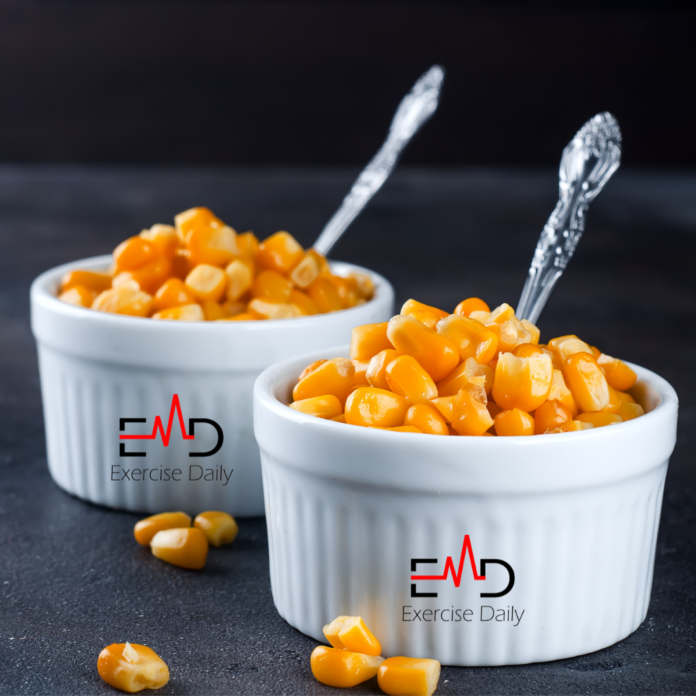Table of Contents
Exercise Daily – Being diabetic means you should be choosy in what you eat. A lot of people ask, “can diabetics eat corn?”.
Well, yes, you can eat corn as a diabetic. Corn is a source of minerals, fibers, vitamins, and energy. Eating corn being a diabetic, won’t affect your sugar levels. In fact, corn is low in fat and sodium.
When it comes to controlling blood sugar levels, some persons with type 2 diabetes might benefit from reducing weight and maintaining it.
While the major focus should be on consuming lots of lean protein and “slow carbs,” which are carbohydrates that digest more slowly and do not immediately turn into glucose in your system, you can indulge in other foods that you may have previously thought off-limits.
It’s a popular misconception among diabetics that all carbs, especially starchy vegetables like maize, are unhealthy for them.
This is not true at all. While maize and diabetes aren’t mutually exclusive, it is important to remember that the serving size should be considered while consuming corn.
Corn and Diabetes – What is the Connection?

A half-cup portion of sweet cooked corn includes 16 grams of carbohydrates, whereas a small ear of corn around 6 inches long contains 19 grams.
According to Harvard Health Publishing, sweet corn falls into the “moderate” glycemic index group when it comes to carbohydrate intake. The glycemic index is a measurement that measures how rapidly a carbohydrate-containing food turns to glucose.
Since we are discussing “can diabetics eat corn,” keep in mind that harmful additives to your cooked corn, such as butter and salt, may increase the amount of saturated fat and sodium in your vegetable.
Toss your portion of corn with a dab of a plant-based butter alternative and a sprinkle of fresh herbs like basil or cilantro to make it more flavorful.
Besides maize, you may eat other foods that contain corn, such as air-popped popcorn, which has 6 grams of carbohydrates in a cup, and popcorn cakes, which contain 8 grams of carbohydrates in a single cake serving.
Check the nutrition label of any processed items that include maize to see how many carbs they contain.
As part of a balanced diet, corn provides additional nutrients such as fiber, which is beneficial for digestive health; vitamin A, which is beneficial for the eyes and skin; and B-family vitamins, which are beneficial for nerve and brain function.
How Much Corn Should You Eat As A Diabetic?
One and a half cups of corn is considered a normal serving size. In comparison, this is approximately the size of one tiny ear of fresh corn. For every half-cup serving of corn, there are 72 calories and 15 grams of carbohydrate.
Scientific Research on Diabetes and Corn
Let’s take a look at what science says about “can diabetics eat corn?”The prevalence of diabetes is 20% greater in nations that have access to high fructose corn syrup than in those that do not.
High fructose corn syrup, a byproduct of corn production, is the focus of most other studies on the subject, and none of this is beneficial.
There is no evidence that eating corn can help treat type 2 diabetes or pre-diabetes. Corn is a high-carbohydrate meal, and the objective is to reduce blood glucose, not raise it, so this isn’t surprising.
On the other hand, research reveals that a low-carb diet is an excellent strategy for controlling blood sugar, A1c, cholesterol, and weight.
When it comes to people with type 2 diabetes, one research contrasted the effects of low carb, high-fat diet (14 percent of energy, no more than 50 grams of carbohydrates per day) with a high carb diet (53 percent of energy).
Both diets helped lower A1c, weight, and fasting glucose levels, according to the study’s findings. Overall glucose management was considerably better with the reduced carb diet, and individuals had lower cholesterol and fewer drugs to take as a result.
Another study compared the long-term health of type 2 diabetics to the effects of a Mediterranean diet low in carbs vs. a low-fat diet.
Low carb Mediterranean diet followers had lower A1C values, better diabetes control, and a longer time before they needed diabetic medication than those who followed the low-fat, high-carb diet, according to the study’s findings.
The results of these (and countless more research) clearly demonstrate the effectiveness of a low-carbohydrate diet.
Nutritional Facts of Corn
Since we are discussing “can diabetics eat corn?” let’s take a look at the nutritional facts of corn.

How To Use Corn In Your Diabetes Meal Plan?
Whether steamed or grilled, corn is an excellent side dish for any meal, especially if you want to keep things simple. Consider using a teaspoon of olive oil along with a pinch of salt to replace the butter for a more flavorful variation in the recipe.
Corn kernels may also be used in salads, soups, and stews since they offer a wonderful texture and flavor to the dish.
Elotes (street corn) are a tasty side dish that blends acidic accent flavors of lime and feta cheese to create a unique flavor combination. The next time you’re barbecuing, try a summer corn salad with black beans and tomatoes, which is perfect for the season.
Diabetes and Popcorns

Popcorn is a nutritious whole grain snack that is low in calories (approximately 30 calories per cup when air-popped) and high in fiber when eaten plain (without oil, butter, or salt) (about 1 gram per cup).
Because high-fiber meals take longer to digest than non-fibrous foods, they help you feel fuller for a longer period of time. One serving of popcorn provides more than 70 percent of the daily recommended consumption of whole grains for most people.
Diabetes and Corn Chips
A lot of people also ask whether diabetics can eat corn chips.
Corn chips, like the majority of fried foods, are heavy in calories, fat, and sodium. Consider the following: a 1-ounce serving of Frito-Lay normal corn chips (approximately 30 chips) has 160 calories, 15 grams of carbohydrate, 1 gram of fiber, 10 grams of fat, and 170 milligrams of sodium.
Taco chips have nutritional values that are comparable to those of tortilla chips: a 1-ounce serving of Tostitos original tortilla chips (approximately 11 chips) includes 140 calories, 19 g carbohydrate, 2 g fiber, 8 g fat, and 120 mg sodium.
Even packaged corn or tortilla chips that are labeled as “baked” or “reduced-fat” include significant levels of salt and have approximately the same number of calories as ordinary chips.
Is There Any Benefit of Eating Corn for Diabetics?
According to a recent study, a high intake of flavonoids, such as those found in corn (which constitute the greatest category of phenolic chemicals present in the crop), lowers the chance of developing chronic illnesses, such as diabetes. The findings of the investigation also revealed:
- Resistance starch (approximately 10 grams per day) derived from corn can help to lower blood glucose levels and insulin responsiveness.
- Increasing your intake of whole-grain corn on a regular basis can enhance your digestive health and reduce your chances of acquiring chronic illnesses such as type 2 diabetes and obesity.
- A further investigation of corn’s bioactive components and their relationship to human health was proposed by the study.
Diabetes and High-fructose Corn Syrup
High-fructose corn syrup is a kind of sweetener derived from corn. It can be found in a variety of processed foods. Some people also ask whether diabetics can eat corn or high-fructose syrup.
People with diabetes must use insulin to maintain their blood sugar levels because, while high-fructose corn syrup doesn’t raise blood sugar levels as much as conventional sugar does, it doesn’t trigger the release of insulin.
Additionally, high-fructose corn syrup has been linked to leptin resistance. As reported in the Journal of Endocrinology, the hormone leptin helps to promote satiety by communicating to the brain that the body is no longer hungry and that it can continue to burn calories at a regular pace.
When Is It Good To Eat Sweet Corn?
Sweet corn is high in protein and provides a significant amount of calories. It contains a substantial amount of carbs as well as fiber. It should be ingested at a time when the body’s energy requirements are at their highest.
The best time to consume is during the morning or afternoon mealtimes. Consumed early in the day, the body has the time to absorb and utilize the energy provided by the sweet corn, which is beneficial.
Moreover, it helps in the prevention of bloating and gas, which are caused by incomplete digestion of the meal.
Sweet corn eating in excess can have a variety of negative consequences. Some of the most frequent ones are as follows:
- stomach aches and pains
- bloating
- diarrhea
- flatulence
It is possible for diabetic people to have a quick spike in blood sugar levels if they overeat sweet corn.
Benefits of Sweet Corn for Diabetes Patients
In diabetic people, sweet corn increases the amount of insulin available in the bloodstream. This supplement also assists in the prevention of blood sugar swings and the development of Type 2 Diabetes.
Aside from treating diabetes, sweet corn is also extremely effective in the prevention of malignancies, particularly colon cancer, and in the preservation of the vitality of the cells of the eye.
Can Diabetics Eat Corn – FAQs
Is sweet corn a high-sugar food?
It is a well-known fact that sweet corn contains a high concentration of minerals and nutrients, making it advantageous to diabetics. However, because sweet corn contains a high concentration of natural sugars, it is recommended that it be taken in moderation.
Is it true that cornmeal raises your blood sugar levels?
Traditionally created in the South, cornbread takes its name from the fact that it contains both cornmeal and fresh or frozen corn. Unfortunately, both of these substances include a significant amount of carbohydrates, which might result in undesired blood sugar rises.
Is it true that corn contains sugar?
The majority of people associate corn with sweet yellow corn, which is a large kind of maize. They also ask whether diabetics can eat corn. It is estimated that one ear of fresh corn weighing 90 grams (g) has 80 calories, according to the United States Department of Agriculture (USDA).
Is sweet corn a high-carbohydrate food?
Corn, like other starchy vegetables such as sweet potato, contains a higher concentration of carbohydrates than light vegetables such as broccoli or Brussels sprouts.
However, one medium ear of corn (equivalent to 12 cup kernels) contains fewer than 100 calories. It’s also low in fat (just 1 gram), and it’s an excellent source of fiber (around 3 grams per serving) (2 grams).
Are tacos dangerous for diabetics?
Tender tacos, burritos, and wraps may be delicious and suitable in your diet; wherever feasible, select whole-wheat tortillas and avoid any fried dishes. Place as many veggies as you can on top of the tacos. If possible, top with a tiny scoop of guacamole.
Is it safe for diabetics to eat eggs?
In terms of carbohydrate content, eggs are a low-carbohydrate item with a very low glycemic index score. As a result, they are an excellent source of protein for those with diabetes.
According to the American Diabetes Association (ADA), eggs are a healthy meal option for persons who have type 2 diabetes.
Is sweet corn in cans a healthy snack?
Fiber and plant chemicals found in corn may have beneficial effects on digestion and visual health, among other things. However, when ingested in large quantities, it is heavy in starch. It might cause blood sugar to increase and may hinder weight reduction.
There are a lot of concerns regarding genetically modified corn or maze. Corn may, however, be a component of a healthy diet if consumed in moderation.
Conclusion
Despite the fact that eating maize has certain advantages, it’s essential to identify how its high carbohydrate content might elevate blood glucose levels and have an influence on how you manage your diabetes.
If you have any more questions like “can diabetics eat corn?” feel free to ask in the comments section below!






